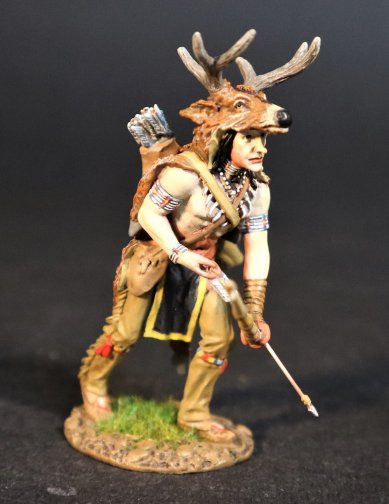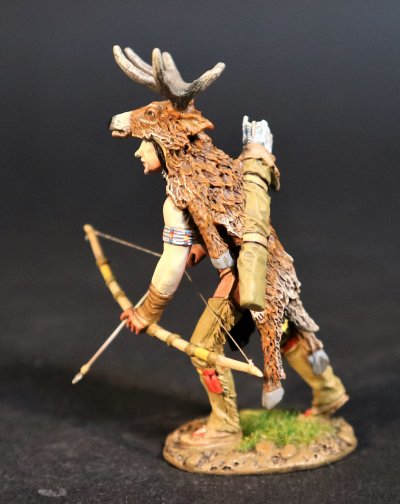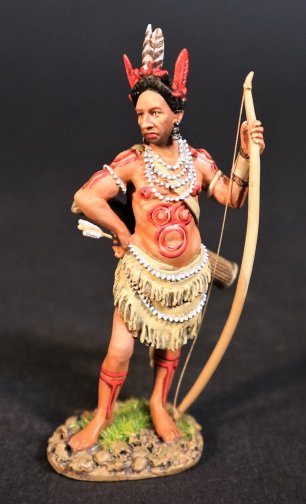- Joined
- Feb 2, 2011
- Messages
- 2,093
NEW RELEASES FOR SEPTEMBER 2022
THE CONQUEST OF AMERICA
SKRAELINGS, THE BEOTHUK
SKRAELING is the name the Norse Greenlanders used for the peoples they encountered in North America, and Greenland.
In the Viking Sagas, it is also used for the peoples of the region known as Vinland whom the Norse encountered during their expeditions there in the early 11[SUP]th[/SUP] Century.

SK-03
THE CONQUEST OF AMERICA,
SKRAELINGS,
BEOTHUK WARRIOR.
(1 pc)
The word Skraeling is most likely related to the old Norse word “skra”, meaning “dried skin”, which is believed to be in reference to the animal pelts worn by the native Americans.
The term is thought to have been first used by Ari Thorgilsson in his work called “The Book Of The Icelanders”. The book was written well after the period in which Norse explorers made their first contacts with indigenous Americans. By the time of the book, Skraeling was probably the common term Norse Greenlanders used for the Thule people, who were the ancestors of the modern Inuit.
The Greenlander’s Saga and the Sago of Erik the Red, which were written in the 13[SUP]th[/SUP] Century, use this term for the people of the area known as Vinland whom the Norse met in the early 11[SUP]th[/SUP] Century. The word has subsequently become well known and has been used in the English language since the 18[SUP]th[/SUP] Century.
Probably the most likely local inhabitants of the area named as Vinland were the Beothuk, or at least their ancestors. The meaning of the word Beothuk is obscure, but “people” or “good people” are possibilities. They lived in villages made up of a number of cone-shaped houses called “Mamateeks”.
Unfortunately the Beothuk have since vanished, with the last of their tribe believed to have died in the 19[SUP]th[/SUP] Century.
Ethnologists have recognized what are at least similarities between the Beothuk peoples and other still existing tribes native to North America, like the Algonquin Indians. This helps give us some insight into the Beothuk, their weapons and the way in which they lived.

There was a vast difference in the weapons possessed by the Beothuk and those available to the Vikings. The most significant variation was the ability of the Vikings to smelt iron in order to create high quality swords and axes, along with iron tipped spears and arrows.
The Beothuk were in awe and fear of these iron weapons. In one saga it tells of “One of the Skraelings had picked up an axe, and after examining it for a moment, he swung it at a man standing beside him, who fell dead at once”.
The vikings had nothing good to say about the people they met. They referred to these people as poor traders, primitive people who were easily scared.
Norse exploration of the new world began with the initial sighting of North America by an Icelander named Bjarni Herjolfsson, who spotted land after drifting off course on a journey to Greenland in 985.
They speculated amongst themselves as to what land this might be, for Bjarni said he suspected this was not Greenland.
His voyage piqued the interest of later explorers including Leif Eriksson, who would explore and name the areas of Helluland, Markland and Vinland.
Eriksson laid the groundwork for later colonizing efforts in the generations to come by establishing a foothold on Vinland, when he constructed some "large houses."
There was great discussion of Leif's Vinland voyage, and his brother Thorvald felt they had not explored enough of the land. Leif then told Thorvald, 'You go to Vinland, brother, and take my ship if you wish, but before you do so I want the ship to make a trip to the skerry to fetch the wood that Thorir had there.”
Thorvald has the first contact with the native population which would come to be known as the Skraelings. After capturing and killing eight of the natives, they were attacked at their beached ships, which they defended.
'I have been wounded under my arm,' he said. 'An arrow flew between the edge of the ship and the shield into my armpit. Here is the arrow, and this wound will cause my death.”
THE POWHATAN

The Powhatan people may refer to any of the indigenous Algonquian people that are traditionally from eastern Virginia. It is estimated that there were about 14,000-21,000 Powhatan people in eastern Virginia, when English colonists established Jamestown in 1607.
In the late 16[SUP]th[/SUP] and early 17[SUP]th[/SUP] centuries, a “Mamanatowick” (paramount chief) named Wahunsenacawh created an organization by affiliating 30 tributary peoples, whose territory was much of eastern Virginia.
They called this area Tsenacommacah (“densely inhabited land”).
Wahunsenacawh came to be known by English colonists as “The Powhatan Chief”.
Each of the tribes within this organization had its own Weroance (leader), but all paid tribute to the Powhatan Chief.

POW-02
THE CONQUEST OF AMERICA,
THE POWHATAN
POWHATAN WARRIOR.
(1 pc)
After Wahunsenacawh’s death in 1618, hostilities with colonists escalated under the chiefdom of his brother, Opchanacanough, who sought in vain to expel encroaching English colonists.
His large scale attacks in 1622 and 1644 met strong reprisals by the colonists, resulting in near elimination of the tribe.
By 1646, what is called the Powhattan Paramount Chiefdom by modern historians had been decimated.
More important than the ongoing conflicts with the English colonial settlements was the high rate of deaths the Powhattan suffered due to new infectious diseases carried to North America by Europeans, such as measles and smallpox.
The native Americans did not have any immunity to these, which had been endemic in Europe and Asia for centuries. The wholesale deaths greatly weakened and hollowed out the native American societies.
By the mid-17[SUP]th[/SUP] century, the leaders of the colony were desperate for labor to develop the land. Almost half of the European immigrants to Virginia arrived as indentured servants.
As settlements continued, the colonists imported growing numbers of enslaved Africans for labour.
By 1700 the colonies had about 6,000 black slaves, which was one-twelfth of the population.
After Bacon’s Rebellion in 1676, the colony enslaved the native Americans for control. In 1691, the House of Burgesses abolished native slavery, however many Powhatan were held in servitude well into the 18[SUP]th[/SUP] Century.
There are several detailed accounts of the Powhatan peoples, but we are fortunate to have the exquisite water-colours of John White, who was the governor of the second Roanoke Settlement.
Luck would have it he was gathering supplies in England when his colony vanished.
The main weapon of all the Indians faced by the English settlers during this period was the longbow. This measured 5-6ft. and was made from witch-hazel or hickory.
It was noted that the Indian bows were quick, but not very strong or accurate.
** PLEASE CONTACT YOUR LOCAL DEALER FOR FURTHER INFORMATION **
THE CONQUEST OF AMERICA
SKRAELINGS, THE BEOTHUK
SKRAELING is the name the Norse Greenlanders used for the peoples they encountered in North America, and Greenland.
In the Viking Sagas, it is also used for the peoples of the region known as Vinland whom the Norse encountered during their expeditions there in the early 11[SUP]th[/SUP] Century.

SK-03
THE CONQUEST OF AMERICA,
SKRAELINGS,
BEOTHUK WARRIOR.
(1 pc)
The word Skraeling is most likely related to the old Norse word “skra”, meaning “dried skin”, which is believed to be in reference to the animal pelts worn by the native Americans.
The term is thought to have been first used by Ari Thorgilsson in his work called “The Book Of The Icelanders”. The book was written well after the period in which Norse explorers made their first contacts with indigenous Americans. By the time of the book, Skraeling was probably the common term Norse Greenlanders used for the Thule people, who were the ancestors of the modern Inuit.
The Greenlander’s Saga and the Sago of Erik the Red, which were written in the 13[SUP]th[/SUP] Century, use this term for the people of the area known as Vinland whom the Norse met in the early 11[SUP]th[/SUP] Century. The word has subsequently become well known and has been used in the English language since the 18[SUP]th[/SUP] Century.
Probably the most likely local inhabitants of the area named as Vinland were the Beothuk, or at least their ancestors. The meaning of the word Beothuk is obscure, but “people” or “good people” are possibilities. They lived in villages made up of a number of cone-shaped houses called “Mamateeks”.
Unfortunately the Beothuk have since vanished, with the last of their tribe believed to have died in the 19[SUP]th[/SUP] Century.
Ethnologists have recognized what are at least similarities between the Beothuk peoples and other still existing tribes native to North America, like the Algonquin Indians. This helps give us some insight into the Beothuk, their weapons and the way in which they lived.

There was a vast difference in the weapons possessed by the Beothuk and those available to the Vikings. The most significant variation was the ability of the Vikings to smelt iron in order to create high quality swords and axes, along with iron tipped spears and arrows.
The Beothuk were in awe and fear of these iron weapons. In one saga it tells of “One of the Skraelings had picked up an axe, and after examining it for a moment, he swung it at a man standing beside him, who fell dead at once”.
The vikings had nothing good to say about the people they met. They referred to these people as poor traders, primitive people who were easily scared.
Norse exploration of the new world began with the initial sighting of North America by an Icelander named Bjarni Herjolfsson, who spotted land after drifting off course on a journey to Greenland in 985.
They speculated amongst themselves as to what land this might be, for Bjarni said he suspected this was not Greenland.
His voyage piqued the interest of later explorers including Leif Eriksson, who would explore and name the areas of Helluland, Markland and Vinland.
Eriksson laid the groundwork for later colonizing efforts in the generations to come by establishing a foothold on Vinland, when he constructed some "large houses."
There was great discussion of Leif's Vinland voyage, and his brother Thorvald felt they had not explored enough of the land. Leif then told Thorvald, 'You go to Vinland, brother, and take my ship if you wish, but before you do so I want the ship to make a trip to the skerry to fetch the wood that Thorir had there.”
Thorvald has the first contact with the native population which would come to be known as the Skraelings. After capturing and killing eight of the natives, they were attacked at their beached ships, which they defended.
'I have been wounded under my arm,' he said. 'An arrow flew between the edge of the ship and the shield into my armpit. Here is the arrow, and this wound will cause my death.”
THE POWHATAN

The Powhatan people may refer to any of the indigenous Algonquian people that are traditionally from eastern Virginia. It is estimated that there were about 14,000-21,000 Powhatan people in eastern Virginia, when English colonists established Jamestown in 1607.
In the late 16[SUP]th[/SUP] and early 17[SUP]th[/SUP] centuries, a “Mamanatowick” (paramount chief) named Wahunsenacawh created an organization by affiliating 30 tributary peoples, whose territory was much of eastern Virginia.
They called this area Tsenacommacah (“densely inhabited land”).
Wahunsenacawh came to be known by English colonists as “The Powhatan Chief”.
Each of the tribes within this organization had its own Weroance (leader), but all paid tribute to the Powhatan Chief.

POW-02
THE CONQUEST OF AMERICA,
THE POWHATAN
POWHATAN WARRIOR.
(1 pc)
After Wahunsenacawh’s death in 1618, hostilities with colonists escalated under the chiefdom of his brother, Opchanacanough, who sought in vain to expel encroaching English colonists.
His large scale attacks in 1622 and 1644 met strong reprisals by the colonists, resulting in near elimination of the tribe.
By 1646, what is called the Powhattan Paramount Chiefdom by modern historians had been decimated.
More important than the ongoing conflicts with the English colonial settlements was the high rate of deaths the Powhattan suffered due to new infectious diseases carried to North America by Europeans, such as measles and smallpox.
The native Americans did not have any immunity to these, which had been endemic in Europe and Asia for centuries. The wholesale deaths greatly weakened and hollowed out the native American societies.
By the mid-17[SUP]th[/SUP] century, the leaders of the colony were desperate for labor to develop the land. Almost half of the European immigrants to Virginia arrived as indentured servants.
As settlements continued, the colonists imported growing numbers of enslaved Africans for labour.
By 1700 the colonies had about 6,000 black slaves, which was one-twelfth of the population.
After Bacon’s Rebellion in 1676, the colony enslaved the native Americans for control. In 1691, the House of Burgesses abolished native slavery, however many Powhatan were held in servitude well into the 18[SUP]th[/SUP] Century.
There are several detailed accounts of the Powhatan peoples, but we are fortunate to have the exquisite water-colours of John White, who was the governor of the second Roanoke Settlement.
Luck would have it he was gathering supplies in England when his colony vanished.
The main weapon of all the Indians faced by the English settlers during this period was the longbow. This measured 5-6ft. and was made from witch-hazel or hickory.
It was noted that the Indian bows were quick, but not very strong or accurate.
** PLEASE CONTACT YOUR LOCAL DEALER FOR FURTHER INFORMATION **

